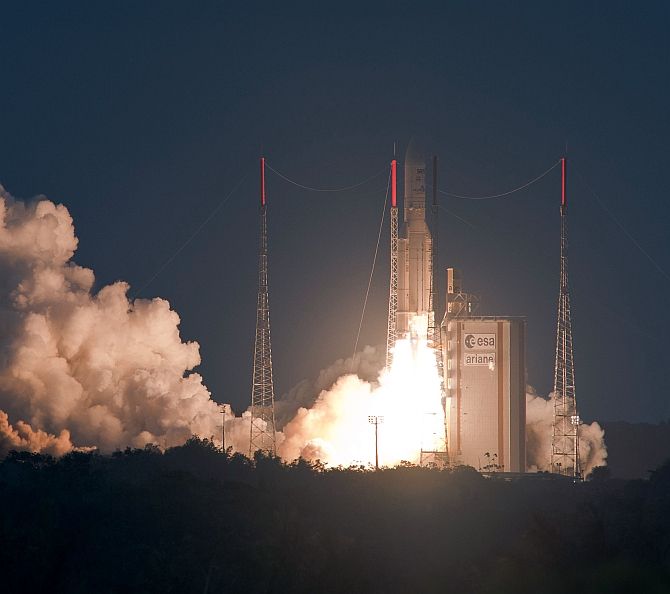Seeking to augment telecommunication, Direct-To-Home and radio navigation services, India's latest communication satellite GSAT-15 was successfully launched by European Ariane rocket from the spaceport of Kourou in French Guiana in the early hours of Wednesday.

The satellite with a lift-off mass of 3,164 kg was injected into the intended Geosynchronous Transfer Orbit (GTO) about 43 minutes after a perfect lift-off of Ariane 5 at 3:04 AM (IST) on flight VA-227.
After a flight of 43 minutes and 24 seconds, GSAT-15 separated from the Ariane 5 upper stage in an elliptical Geosynchronous Transfer Orbit (GTO) with a perigee (nearest point to Earth) of 250 km and an apogee (farthest point to Earth) of 35,819 km, ISRO said.
GSAT-15 was hurtled into the orbit very close to the intended one after its co-passenger Arabsat-6B (BADR-7) was injected into the space.
A high power satellite, GSAT-15 is being inducted into the INSAT/GSAT system. GSAT-15 carries a total of 24 communication transponders in Ku-band as well as a GPS-Aided GEO Augmented Navigation (GAGAN) payload operating in L1 and L5 bands.
Providing replacement for the Ku-band capacity of INSAT-3A and INSAT-4B satellites, GSAT-15 will augment and support the existing DTH and VSAT services in the country. The GAGAN payload will meet the in-orbit redundancy requirement for Safety of Life (SOL) operations benefiting the civil aviation services and other users of augmented GPS-based systems in the country.
ISRO's Master Control Facility (MCF) at Hassan in Karnataka took over the command and control of GSAT-15 immediately after its separation from the launch vehicle.
Preliminary health checks of the satellite revealed its normal health, ISRO said in Bengaluru.
Speaking at the launch facility in Kourou, ISRO Satellite Centre (ISAC) Director M Annadurai said the launch of GSAT-15 will enable ISRO to provide continuity of service to Indian users in Ku-band.
The navigation payload GAGAN will provide in-orbit backup to ensure safety of life navigation services in civil aviation sector as well as other location based services to various users in the Indian region, Annadurai said.
Annadurai also said other two communication satellites GSAT-17 and GSAT-18 were getting ready for launch by Ariane vehicle during the next year. "The realisation of both the satellites are in very advanced stage."
In the coming days, orbit raising manoeuvres will be performed to place the satellite in the Geostationary Orbit (36,000 km above the equator) by using the satellite's propulsion system, ISRO said.
After the completion of orbit raising operations, the two solar arrays and both the antenna reflectors of GSAT-15 will be deployed. Following this, the satellite will be put in its final orbital configuration, ISRO said, adding after the successful completion of all the in-orbit tests, the satellite will be ready for operational use.
With the designed in-orbit operational life of 12 years, GSAT-15 will be positioned at 93.5 deg East longitude and co-located with INSAT-3A and INSAT-4B satellites that will be completing their tenure-- one this month and the other next year.
"The launch of GSAT-15 will be one more step towards further strengthening the satellite navigation infrastructure and sustaining the communication infrastructure in the country," ISRO Chairman A S Kiran Kumar said in a recorded video message.
Arabsat-6B (BADR 7) satellite is the first of the sixth generation of satellites in the Arabsat fleet, It will provide telecommunications and direct- to-home (DTH) TV broadcast services for the Middle East, Africa and Central Asia.
GSAT-15 is the 19th payload launched by Arianespace for ISRO.






